Abstract
The pancreatic B-cell may represent a fuel-sensor organ, the release of insulin evoked by nutrient secretagogues being attributable to an increased oxidation of exogenous and/or endogenous substrates. The participation of endogenous fatty acids in the secretory response of isolated rat pancreatic islets was investigated. Methyl palmoxirate (McN-3716, 0.1 mM), an inhibitor of long-chain-fatty-acid oxidation, suppressed the oxidation of exogenous [U-14C]palmitate and inhibited 14CO2 output from islets prelabelled with [U-14C]palmitate. Methyl palmoxirate failed to affect the oxidation of exogenous D-[U-14C]glucose or L-[U-14C]glutamine, the production of NH4+ and the output of 14CO2 from islets prelabelled with L-[U-14C]glutamine. In the absence of exogenous nutrient and after a lag period of about 60 min, methyl palmoxirate decreased O2 uptake to 69% of the control value. Methyl palmoxirate inhibited insulin release evoked by D-glucose, D-glyceraldehyde, 2-oxoisohexanoate, L-leucine, 2-aminobicyclo[2.2.1]heptane-2-carboxylate or 3-phenylpyruvate. However, methyl palmoxirate failed to affect insulin release when the oxidation of endogenous fatty acids was already suppressed, e.g. in the presence of pyruvate or L-glutamine. These findings support the view that insulin release evoked by nutrient secretagogues tightly depends on the overall rate of nutrient oxidation, including that of endogenous fatty acids.
Full text
PDF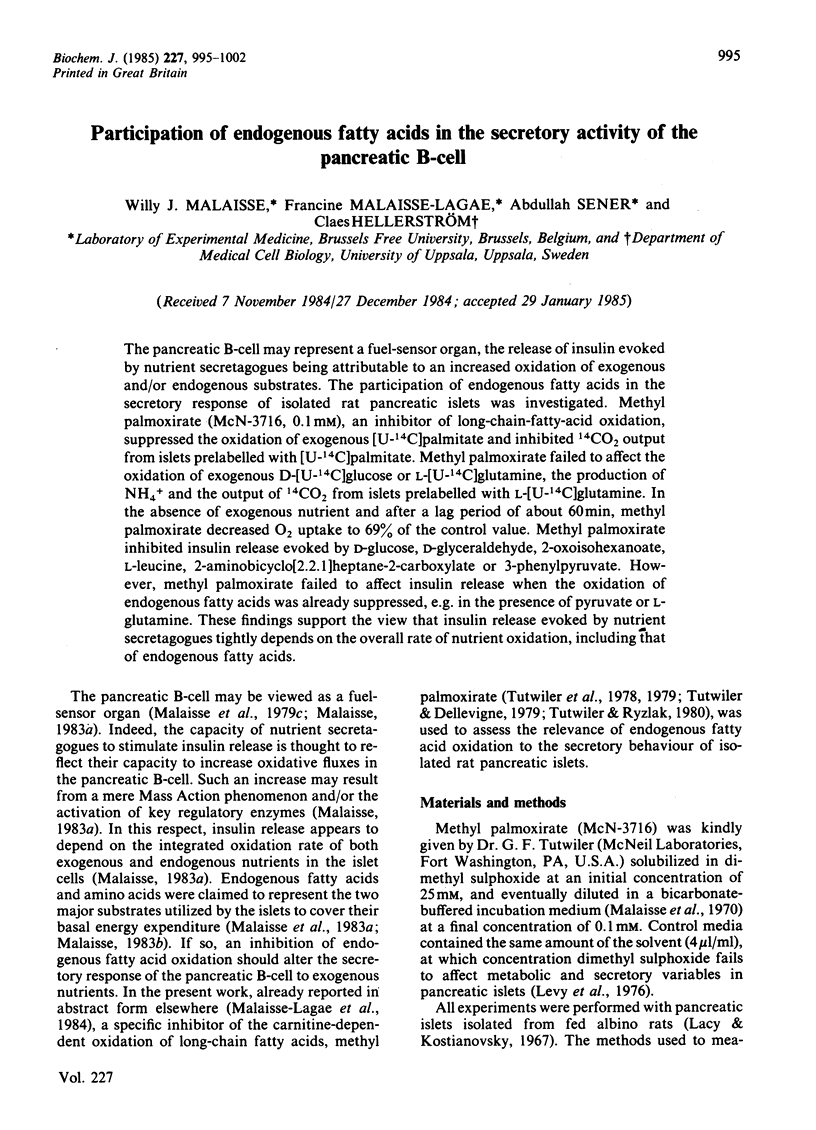
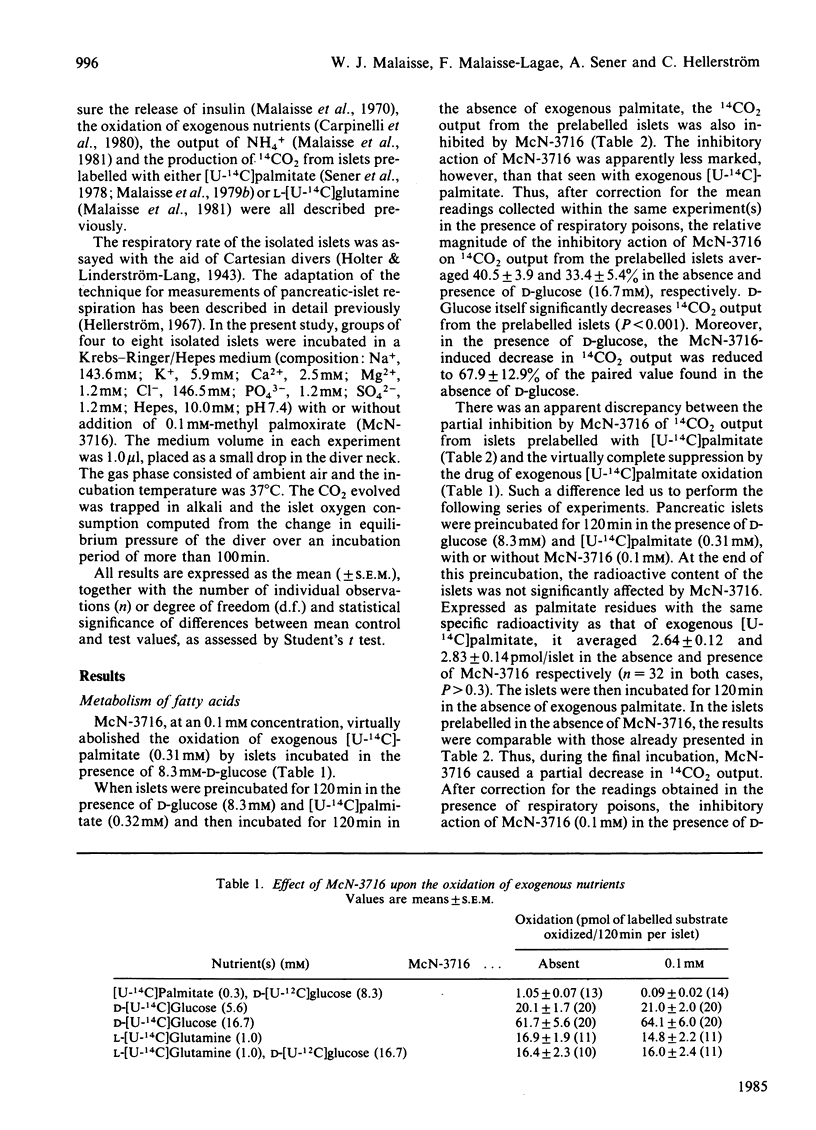
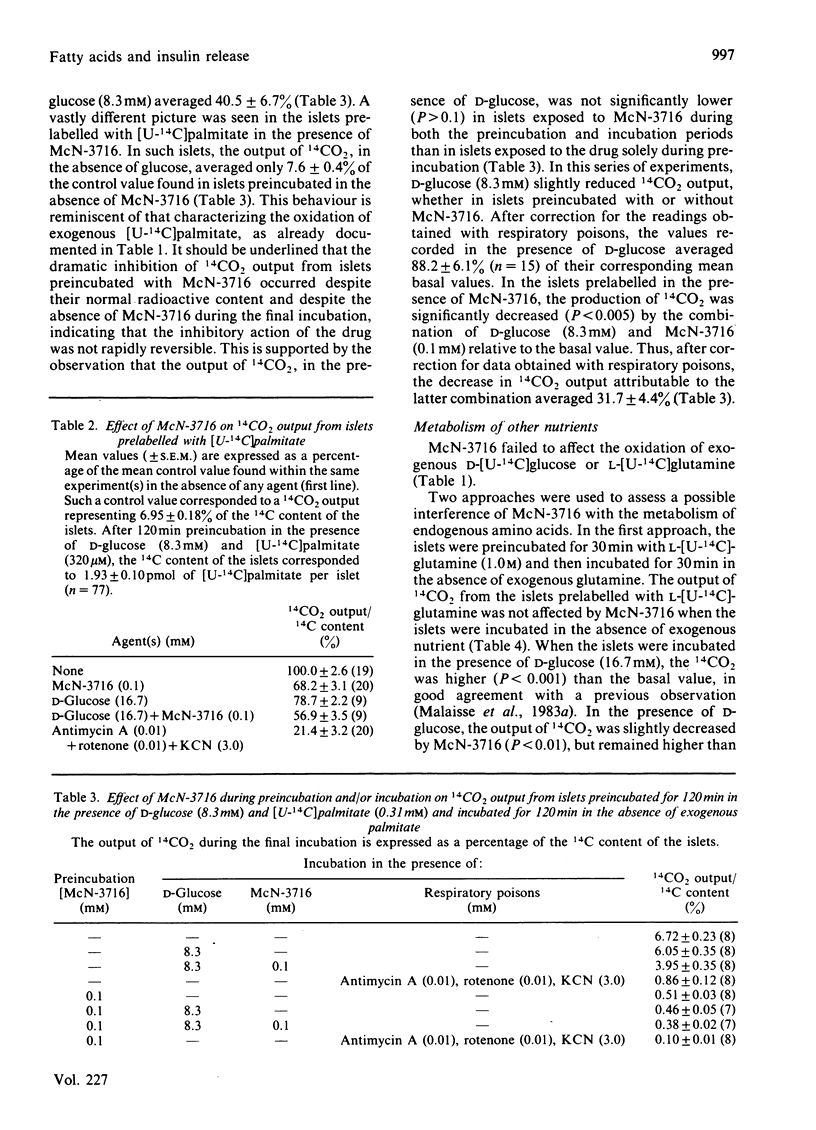
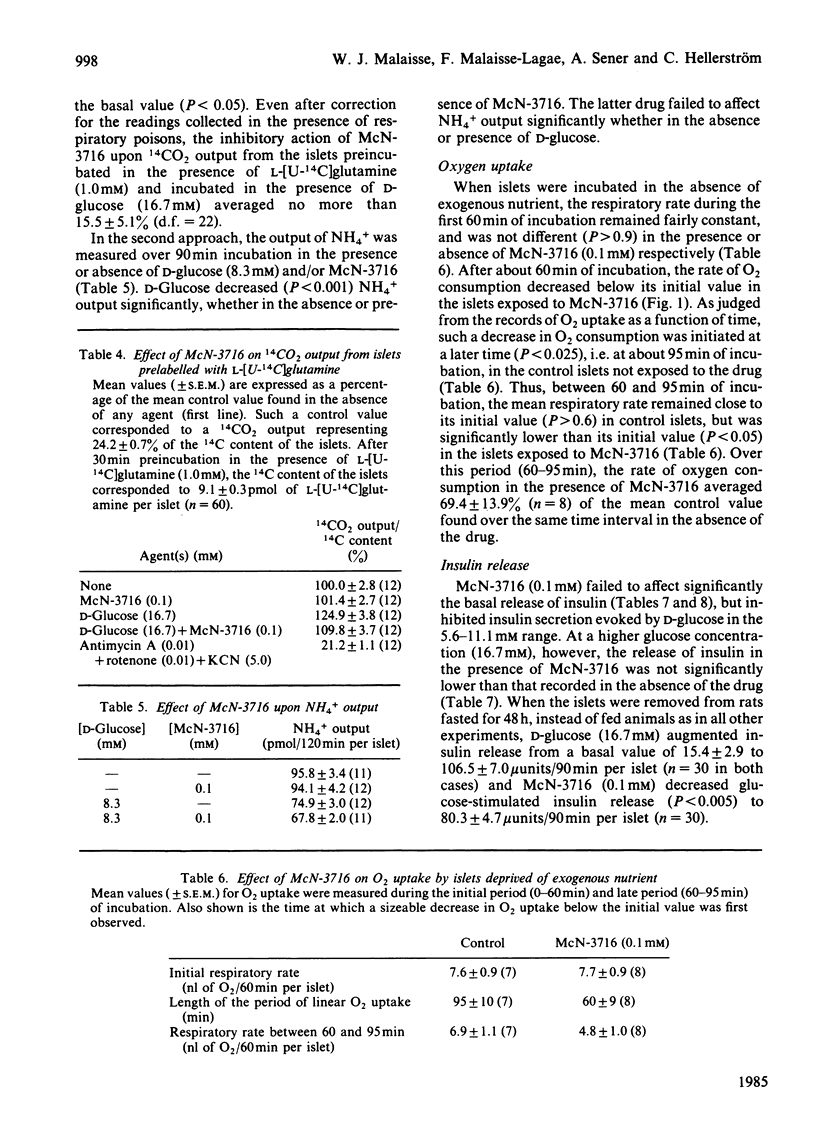
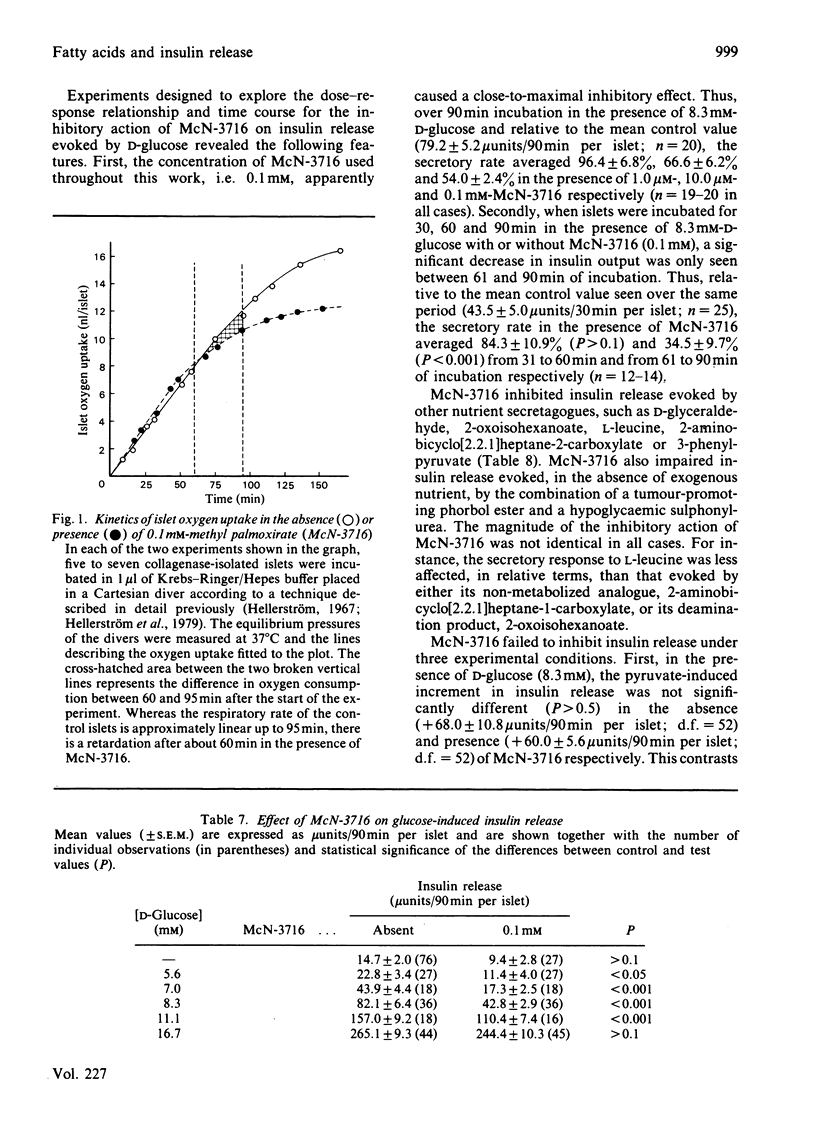
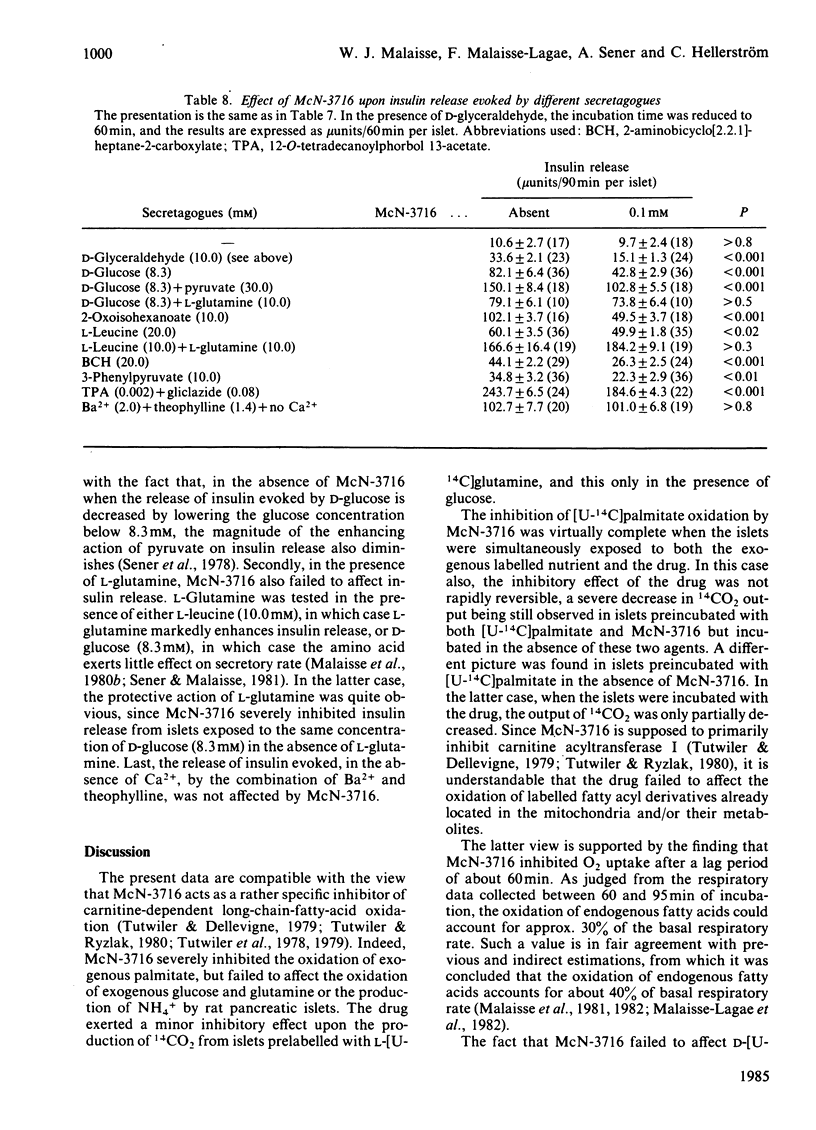
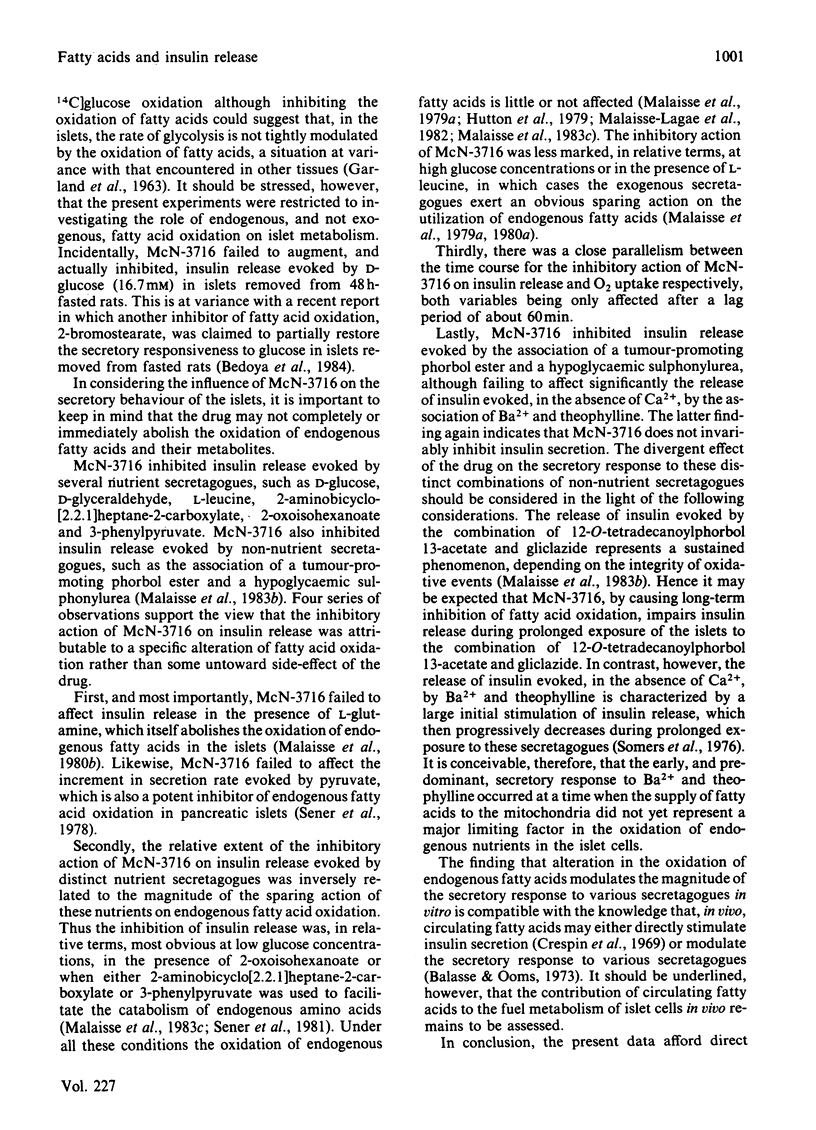
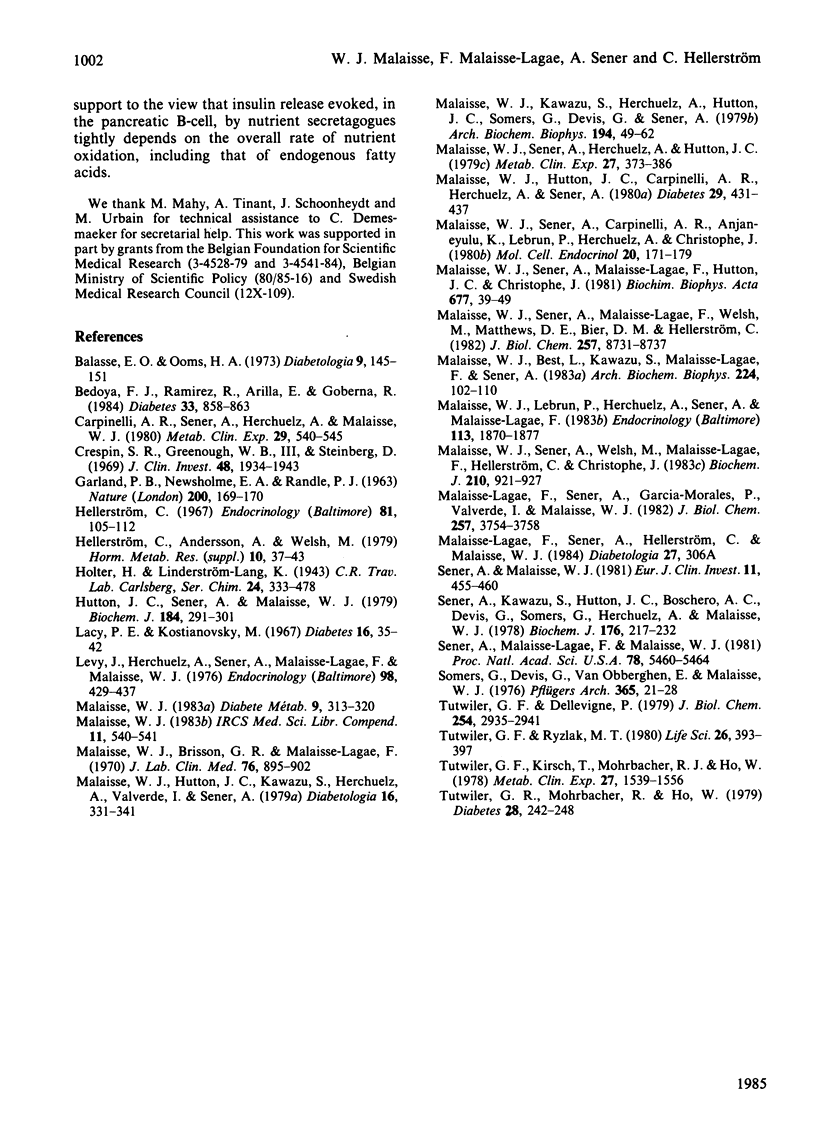
Selected References
These references are in PubMed. This may not be the complete list of references from this article.
- Balasse E. O., Ooms H. A. Role of plasma free fatty acids in the control of insulin secretion in man. Diabetologia. 1973 Apr;9(2):145–151. doi: 10.1007/BF01230695. [DOI] [PubMed] [Google Scholar]
- Bedoya F. J., Ramírez R., Arilla E., Goberna R. Effect of 2-bromostearate on glucose-phosphorylating activities and the dynamics of insulin secretion in islets of Langerhans during fasting. Diabetes. 1984 Sep;33(9):858–863. doi: 10.2337/diab.33.9.858. [DOI] [PubMed] [Google Scholar]
- Carpinelli A. R., Sener A., Herchuelz A., Malaisse W. J. Stimulus-secretion coupling of glucose-induced insulin release. Effect of intracellular acidification upon calcium efflux from islet cells. Metabolism. 1980 Jun;29(6):540–545. doi: 10.1016/0026-0495(80)90079-7. [DOI] [PubMed] [Google Scholar]
- Crespin S. R., Greenough W. B., 3rd, Steinberg D. Stimulation of insulin secretion by infusion of free fatty acids. J Clin Invest. 1969 Oct;48(10):1934–1943. doi: 10.1172/JCI106160. [DOI] [PMC free article] [PubMed] [Google Scholar]
- GARLAND P. B., RANDLE P. J., NEWSHOLME E. A. CITRATE AS AN INTERMEDIARY IN THE INHIBITION OF PHOSPHOFRUCTOKINASE IN RAT HEART MUSCLE BY FATTY ACIDS, KETONE BODIES, PYRUVATE, DIABETES, AND STARVATION. Nature. 1963 Oct 12;200:169–170. doi: 10.1038/200169a0. [DOI] [PubMed] [Google Scholar]
- Hellerström C., Andersson A., Welsh M. Respiration of the pancreatic B-cell: effects of glucose and 2-aminonorbornane-2-carboxylic acid. Horm Metab Res Suppl. 1980;Suppl 10:37–43. [PubMed] [Google Scholar]
- Hellerström C. Effects of carbohydrates on the oxygen consumption of isolated pancreatic islets of mice. Endocrinology. 1967 Jul;81(1):105–112. doi: 10.1210/endo-81-1-105. [DOI] [PubMed] [Google Scholar]
- Hutton J. C., Sener A., Malaisse W. J. The metabolism of 4-methyl-2-oxopentanoate in rat pancreatic islets. Biochem J. 1979 Nov 15;184(2):291–301. doi: 10.1042/bj1840291. [DOI] [PMC free article] [PubMed] [Google Scholar]
- Lacy P. E., Kostianovsky M. Method for the isolation of intact islets of Langerhans from the rat pancreas. Diabetes. 1967 Jan;16(1):35–39. doi: 10.2337/diab.16.1.35. [DOI] [PubMed] [Google Scholar]
- Levy J., Herchuelz A., Sener A., Malaisse-Lagae F., Malaisse W. J. Cytochalasin B-induced impariment of glucose metabolism in islets of Langerhans. Endocrinology. 1976 Feb;98(2):429–437. doi: 10.1210/endo-98-2-429. [DOI] [PubMed] [Google Scholar]
- Malaisse-Lagae F., Sener A., Garcia-Morales P., Valverde I., Malaisse W. J. The stimulus-secretion coupling of amino acid-induced insulin release. Influence of a nonmetabolized analog of leucine on the metabolism of glutamine in pancreatic islets. J Biol Chem. 1982 Apr 10;257(7):3754–3758. [PubMed] [Google Scholar]
- Malaisse W. J., Best L., Kawazu S., Malaisse-Lagae F., Sener A. The stimulus-secretion coupling of glucose-induced insulin release: fuel metabolism in islets deprived of exogenous nutrient. Arch Biochem Biophys. 1983 Jul 1;224(1):102–110. doi: 10.1016/0003-9861(83)90193-5. [DOI] [PubMed] [Google Scholar]
- Malaisse W. J., Brisson G., Malaisse-Lagae F. The stimulus-secretion coupling of glucose-induced insulin release. I. Interaction of epinephrine and alkaline earth cations. J Lab Clin Med. 1970 Dec;76(6):895–902. [PubMed] [Google Scholar]
- Malaisse W. J., Hutton J. C., Carpinelli A. R., Herchuelz A., Sener A. The stimulus-secretion coupling of amino acid-induced insulin release: metabolism and cationic effects of leucine. Diabetes. 1980 Jun;29(6):431–437. doi: 10.2337/diab.29.6.431. [DOI] [PubMed] [Google Scholar]
- Malaisse W. J., Hutton J. C., Kawazu S., Herchuelz A., Valverde I., Sener A. The stimulus-secretion coupling of glucose-induced insulin release. XXXV. The links between metabolic and cationic events. Diabetologia. 1979 May;16(5):331–341. doi: 10.1007/BF01223623. [DOI] [PubMed] [Google Scholar]
- Malaisse W. J. Insulin release : the fuel concept. Diabete Metab. 1983 Dec;9(4):313–320. [PubMed] [Google Scholar]
- Malaisse W. J., Kawazu S., Herchuelz A., Hutton J. C., Somers G., Devis G., Sener A. The stimulus secretion coupling of glucose-induced insulin release. Arch Biochem Biophys. 1979 Apr 15;194(1):49–62. doi: 10.1016/0003-9861(79)90594-0. [DOI] [PubMed] [Google Scholar]
- Malaisse W. J., Lebrun P., Herchuelz A., Sener A., Malaisse-Lagae F. Synergistic effect of a tumor-promoting phorbol ester and a hypoglycemic sulfonylurea upon insulin release. Endocrinology. 1983 Nov;113(5):1870–1877. doi: 10.1210/endo-113-5-1870. [DOI] [PubMed] [Google Scholar]
- Malaisse W. J., Sener A., Carpinelli A. R., Anjaneyulu K., Lebrun P., Herchuelz A., Christophe J. The stimulus-secretion coupling of glucose-induced insulin release. XLVI. Physiological role of L-glutamine as a fuel for pancreatic islets. Mol Cell Endocrinol. 1980 Nov;20(2):171–189. doi: 10.1016/0303-7207(80)90080-5. [DOI] [PubMed] [Google Scholar]
- Malaisse W. J., Sener A., Herchuelz A., Hutton J. C. Insulin release: the fuel hypothesis. Metabolism. 1979 Apr;28(4):373–386. doi: 10.1016/0026-0495(79)90111-2. [DOI] [PubMed] [Google Scholar]
- Malaisse W. J., Sener A., Malaisse-Lagae F., Welsh M., Matthews D. E., Bier D. M., Hellerström C. The stimulus-secretion coupling of amino acid-induced insulin release. Metabolic response of pancreatic islets of L-glutamine and L-leucine. J Biol Chem. 1982 Aug 10;257(15):8731–8737. [PubMed] [Google Scholar]
- Malaisse W. J., Sener A., Malaisse-Legae F., Hutton J. C., Christophe J. The stimulus-secretion coupling of amino acid-induced insulin release. Metabolic interaction of L-glutamine and 2-ketoisocaproate in pancreatic islets. Biochim Biophys Acta. 1981 Sep 18;677(1):39–49. doi: 10.1016/0304-4165(81)90143-4. [DOI] [PubMed] [Google Scholar]
- Malaisse W. J., Sener A., Welsh M., Malaisse-Lagae F., Hellerström C., Christophe J. Mechanism of 3-phenylpyruvate-induced insulin release. Metabolic aspects. Biochem J. 1983 Mar 15;210(3):921–927. doi: 10.1042/bj2100921. [DOI] [PMC free article] [PubMed] [Google Scholar]
- Sener A., Kawazu S., Hutton J. C., Boschero A. C., Devis G., Somers G., Herchuelz A., Malaisse W. J. The stimulus-secretion coupling of glucose-induced insulin release. Effect of exogenous pyruvate on islet function. Biochem J. 1978 Oct 15;176(1):217–232. doi: 10.1042/bj1760217. [DOI] [PMC free article] [PubMed] [Google Scholar]
- Sener A., Malaisse-Lagae F., Malaisse W. J. Stimulation of pancreatic islet metabolism and insulin release by a nonmetabolizable amino acid. Proc Natl Acad Sci U S A. 1981 Sep;78(9):5460–5464. doi: 10.1073/pnas.78.9.5460. [DOI] [PMC free article] [PubMed] [Google Scholar]
- Sener A., Malaisse W. J. The stimulus-secretion coupling of amino acid-induced insulin release: insulinotropic action of branched-chain amino acids at physiological concentrations of glucose and glutamine. Eur J Clin Invest. 1981 Dec;11(6):455–460. doi: 10.1111/j.1365-2362.1981.tb02013.x. [DOI] [PubMed] [Google Scholar]
- Somers G., Devis G., van Obberghen E., Malaisse W. J. Calcium-antagonists and islet function. VI. Effects of barium. Pflugers Arch. 1976 Sep 3;365(1):21–28. doi: 10.1007/BF00583624. [DOI] [PubMed] [Google Scholar]
- Tutwiler G. F., Dellevigne P. Action of the oral hypoglycemic agent 2-tetradecylglycidic acid on hepatic fatty acid oxidation and gluconeogenesis. J Biol Chem. 1979 Apr 25;254(8):2935–2941. [PubMed] [Google Scholar]
- Tutwiler G. F., Kirsch T., Mohrbacher R. J., Ho W. Pharmacologic profile of methyl 2-tetradecylglycidate (McN-3716)--an orally effective hypoglycemic agent. Metabolism. 1978 Oct;27(10):1539–1556. doi: 10.1016/s0026-0495(78)80027-4. [DOI] [PubMed] [Google Scholar]
- Tutwiler G. F., Mohrbacher R., Ho W. Methyl 2-tetradecylglycidate, an orally effective hypoglycemic agent that inhibits long chain fatty acid oxidation selectively. Diabetes. 1979 Mar;28(3):242–248. doi: 10.2337/diab.28.3.242. [DOI] [PubMed] [Google Scholar]
- Tutwiler G. F., Ryzlak M. T. Inhibition of mitochondrial carnitine palmitoyl transferase by 2-tetradecylglycidic acid (McN-3802) (preliminary communication). Life Sci. 1980 Feb 4;26(5):393–397. doi: 10.1016/0024-3205(80)90156-3. [DOI] [PubMed] [Google Scholar]


